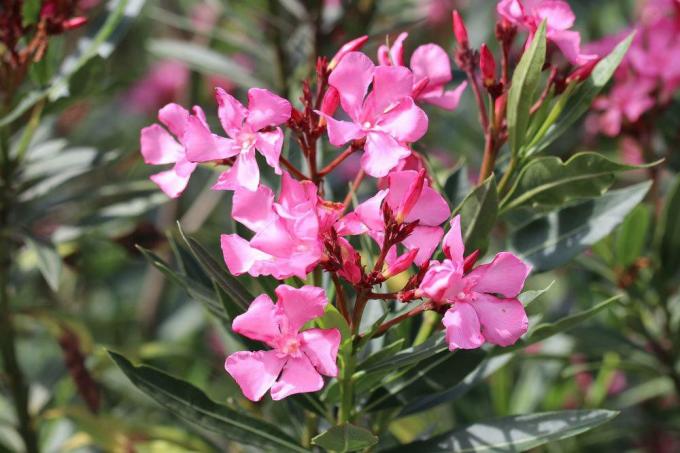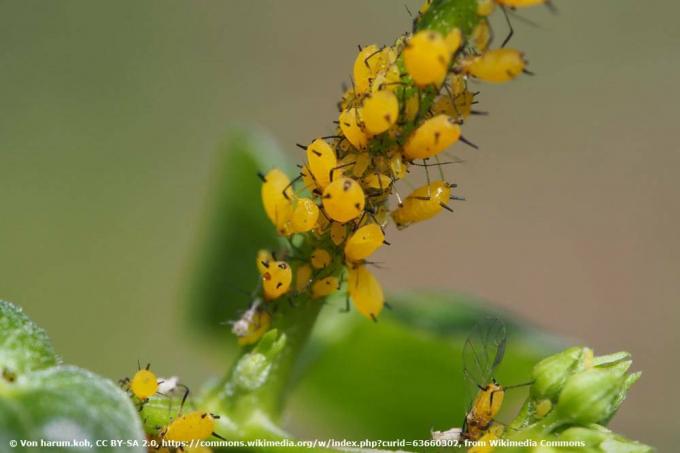
table of contents
- Cut oleander
- time
- safety instructions
- Instructions for pruning
- Radical cut
- Parental cuts
- Mitigation of pests and diseases
Of the oleander (Nerium oleander) is one of the most popular perennials for growing in pots. From June to September it forms numerous flowers. The prerequisite for this is proper care, which primarily includes pruning. Courage is required when cutting, because the perennials need a strong cut so that they not only bloom profusely, but also to protect them from diseases and pests.
Cut oleander
time
The oleander originally comes from the warm Mediterranean region and stands for Mediterranean flair. It can only tolerate frost to a limited extent and this must also be taken into account when choosing the right time for cutting. Basically, oleanders can be cut in spring or autumn.
Pruning in spring promotes strong budding, while pruning in autumn ensures that the plant survives winter well in protected indoor spaces. By pruning in autumn, the plant has to provide less mass, which also simplifies maintenance. In addition, will
Diseases and Pests during the critical Wintering phase less attack surface offered.safety instructions
Nerium oleander has toxic ingredientswhich can be dangerous, especially when cutting the perennials. When cutting, a white sap emerges from the wood, which can cause allergic reactions if it comes into contact with the skin. In addition, the branches are flexible, which means that a branch held for cutting may also distribute its sap when it snaps back.
This can be especially uncomfortable if the juice gets on mucous membranes or in the eyes. Therefore, when working on the oleander, not only gloves should be worn, but also suitable protection for the eyes, especially with very large plants.

Note: In autumn the plant has less sap as it concentrates its forces more in the area of the roots. Cutting back at this time is therefore a little less risky, but not entirely harmless.
Instructions for pruning
Before the oleander is cut, it should be dry several days before and after the cut. A high level of humidity favors a fungal attack at the open interfaces. Therefore, spring is usually a better time to cut than autumn, as autumn is the time to cut Humidity is usually higher and, as a result, already infected plants in winter quarters are also other perennials can infect.
Cut the oleander in 6 steps:
- Have cleaned scissors and, if necessary, a saw ready
- Put on protective clothing
- Choose the main shoot for height gain
- Select the clearing branches and remove them completely
- Shorten other branches to the ninth bud
- Remove shoots close to the ground
The leading shoot is always a little longer than the other shoots. It usually determines the structure of the shrub and is also the branch that forces the supply of the other branches. If the guide branch is removed, the shrub is also restricted in its height growth, which is sometimes the case with very large and old shrubs.
tip: In the case of heavily lignified plants with large interfaces, these can be closed with a suitable tree wax for interfaces, which reduces the risk of diseases.
Cut dead plant parts regularly
Regardless of when you cut, you must regularly remove dead plant parts. These not only look unsightly, diseases can also take their starting point or pests settle there. Compared to the annual pruning, however, in this case you do not cut into fresh parts of the plant, but only cut briefly above.
tip: You could also pluck off dead plant parts, but then there is a high risk that you will damage healthy plant material. Therefore, you should also remove dead leaves and flowers with sharp scissors.
If you're removing dead plant parts, so can you Correction cuts make. This is necessary if branches grow transversely inside or if shoots hang over the edge of the pot near the ground. Overhanging shoots are particularly common, as the oleander reproduces via shoots lying on the ground, which, however, are not desirable in potted cultivation.
In the case of correction cuts, the fresh plant material is definitely cut. These also have the advantage that they extend the flowering period as they stimulate flower growth.
Radical cut
If you cut your oleander regularly, in most cases you only need to remove a little. Nevertheless, it can happen that a radical cut is necessary. This is always the case when:
- the plants are too big.
- the bush is infested with pests.
- diseases have developed.
- the shrub should be given a new shape.
- the shrub is threatened with balding.
In order to be able to subject an oleander to a radical pruning, you should first check the roots. The branches may only be shortened when the root ball is healthy. Plants with healthy roots can be shortened to a height of 40-50 cm without any problems. With older plants, you often even have to use a saw to make radical cuts because the branches are too thick for scissors.
A radical cut promotes the formation of shoots from the rhizome. This creates shoots that are very close to the ground, which make Nerium oleander look like a bush again.
Parental cuts
A special challenge when cutting Nerium oleander are training pruning, especially if the shrub is to grow in the form of a half-trunk. Raising young plants is not easy either, because although the oleander grows quickly, if it is faulty it can take several years for the plants to achieve their old shine.
When raising young perennials, the main thing you should pay attention to is a beautiful crown. To do this, remove the branches that obstruct it. This mainly applies to new shoots that can obstruct beautiful, strong branches. In addition, the shrub should have a light and airy crown that also gives the flowers enough space. Therefore, you should also remove thin branches that are too close to the main branches.
When raising a standard trunk, the main thing that you should pay attention to is a straight guide branch. A healthy, strong and, above all, straight branch is chosen, which should form the trunk in the future. You have to consistently remove secondary shoots on the trunk, as growth should be restricted to the crown.
Mitigation of pests and diseases
A pruning is essential if the plant is attacked by pests or diseases. Basically, in this case, as little as possible applies, but as much as necessary. Therefore, it may be that, especially in this case, a vigorous pruning is essential.
However, the cut is only limited to the infected areas, which you should then shorten well. Every bud that is preserved has the potential to produce flowers despite diseases or pests. In this case, it is very important to follow the instructions and, at the end, to disinfect the cutting tool used. You should dispose of sick clippings in the residual waste.




